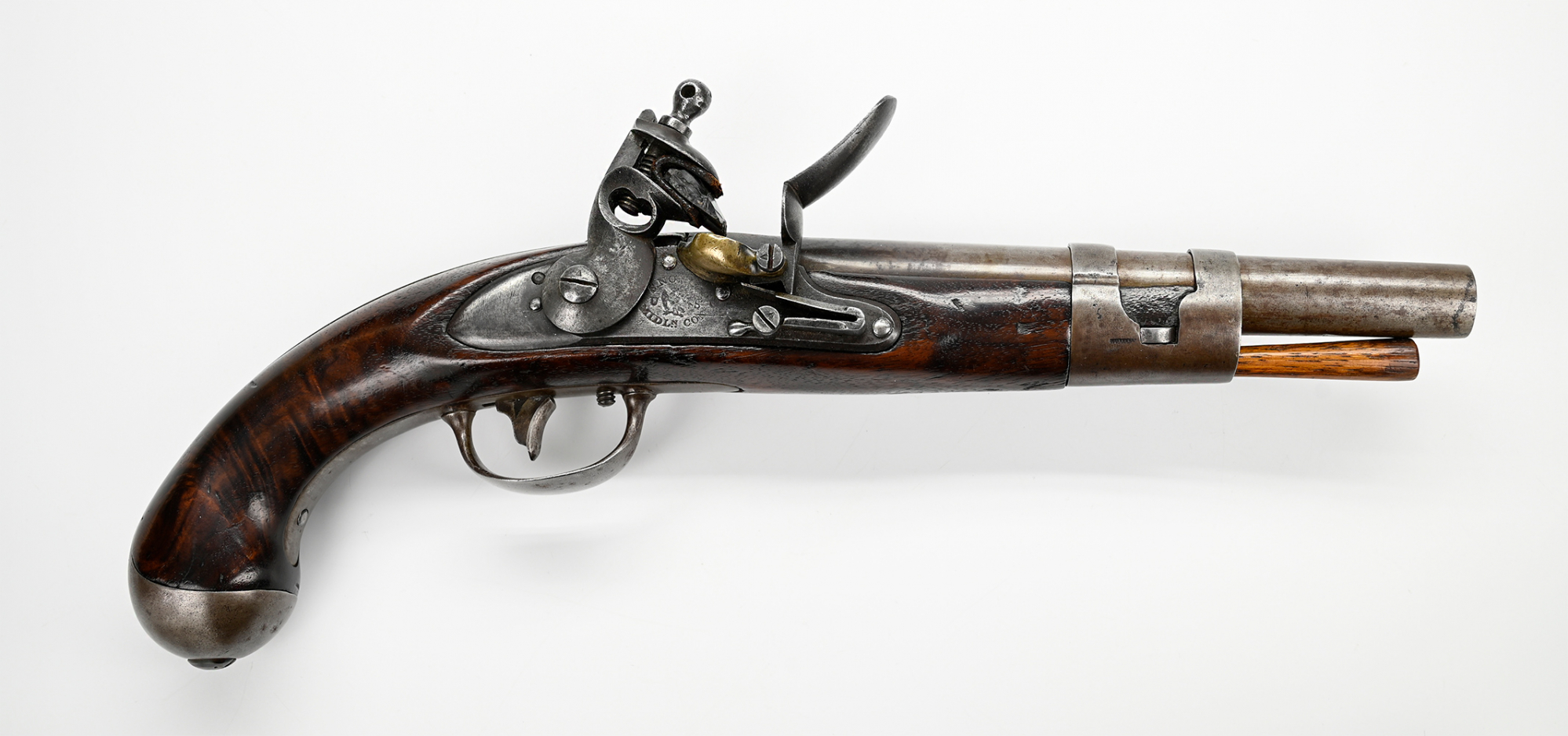site search
online catalog
RARE SIMEON NORTH U.S. MODEL 1813 ARMY PISTOL

$3,795.00 SOLD
Quantity Available: None
Item Code: 490-4657
Smith and Bittner, Historic Pistols, call this War of 1812 pistol, “one of the rarest U.S. martial pistols.” It is generally accepted that just 626 were manufactured and delivered to the army by Simeon North between the signing of the contract in April 1813 and cessation of manufacture in 1815, and possibly as few as 541 of this configuration. The pistol features a nominally 9” inch barrel in .69 caliber (barrel lengths might vary as much as 1/8”) and follows the lines of North’s improved Model 1811 pistols using the double-strapped Wickham nose band with the stock ending flush with it, but uses a simple, inclined separate brass pan without fence, eliminates the bent tip of the frizzen, and uses a lock plate beveled at the front and slightly rounded at the rear. These were produced by North at his new factory in Middletown, CT, and the lock plates are marked forward of the hammer, S. NORTH / U [EAGLE] S / MIDLN CON. with the upper and lower lines in arcs surrounding the middle US/[eagle] motif. The left barrel flat has stamped P/US proofs.
It turned out that .69 caliber, though fine for a musket, was a bit much for a pistol and the contract, which had called for 20,000 pistols, was suspended in 1815 after just 626 had been supplied. Of these, perhaps 85 had been fabricated using older, shorter, Model 1811 pistol barrels and flat lock plates, leaving about 541 of this configuration. The contract was renegotiated in January 1816 for the difference of 19,374 pistols, but in .54 caliber, a pattern that became North’s Model 1816. This left North with a large number of .69 caliber pistol barrels and other parts on hand, but he managed to put them to use in fulfilling a navy contract for 1,000 pistols, signed in September 1816 and completed in November, likely with a sigh of relief. Those navy versions are distinguishable from this even scarcer army version by their “E.T.” inspector cartouches, naval belt hooks or, if the hook is missing, longer rear lock screws used to anchor the belt hooks, or a plugged hole in the side flat to the rear of that screw that had once secured the belt hook stud.
The example is in very good condition. The barrel is smooth metal, showing steel gray with some darker gray spots and shading slightly toward brown near the breech. As is correct for the model, it has no sights. The P/US barrel proof is very good with the P showing some rubbing but legible. The counterpane shows dings and stains, but we can make out a faint oval from an inspector’s cartouche just to the right of the upper lock screw. This would be the “LS” mark of Luther Sage. The only other inspector known, Henry Peterkin, would also have had his initials on the counterpane, but additionally marked his barrels with an “H.H.P.” on the right breech, whereas as Sage marked only the counterpane. The wood overall has a tight fit to the metal and a good, warm brown tone mixed with some darker areas lending it a pleasing, grained look, and surface with some dings and short scratches on the underside near the trigger guard, the upper left grip, and counterpane. The pistol has a wood ramrod, lighter in color, that is likely a replacement. The wood rammer had a metal ferrule slotted for cleaning patches and female threads for the attachment of cleaning and ball pulling tips. Bore is very clean; the hammer stops at half cock but the trigger does not lock in the safety position.
In addition to their historical interest, these pistols are also part of the progression of U.S. industry toward mass, assembly-line, production and manufacturing tolerances close enough to make parts interchangeable. In fact, this latter point is said to have been included in North’s contract, though he apparently only referred to making the locks so uniform that they might be switched in a letter mentioned by Smith and Bittner. North did organize his production using specialized labor, which would produce greater uniformity and perhaps parts that were “identical,” but interchangeable was another question and goal yet to be achieved: we note the appearance of mating numbers/symbols on the lock screws and side plate of this pistol.
This is a very hard to find pistol in very good condition and original flint. [sr] [ph:m]
DISCLAIMER: All firearms are sold as collector's items only - we do not accept responsibility as to the shooting safety or reliability of any antique firearm. All firearms are described as accurately as possible, given the restraints of a catalog listing length. We want satisfied customers & often "under" describe the weapons. Any city or state regulations regarding owning antique firearms are the responsibility of the purchaser. All firearms are "mechanically perfect" unless noted, but again, are NOT warranted as safe to fire!
~~~~~~~~~~~~~~~~~~~~~~~~~~~~~~~~~~~
THIS ITEM, AS WITH ALL OTHER ITEMS AVAILABLE ON OUR WEB SITE,
MAY BE PURCHASED THROUGH OUR LAYAWAY PROGRAM.
CLICK HERE FOR OUR POLICIES AND TERMS.
THANK YOU!
Inquire About RARE SIMEON NORTH U.S. MODEL 1813 ARMY PISTOL
For inquiries, please email us at [email protected]
Most Popular
Historical Firearms Stolen From The National Civil War Museum In Harrisburg, Pa »
Theft From Gravesite Of Gen. John Reynolds »
Fine Condition Brass Infantry Bugle Insignia »
Selection Of Unframed Prints By Don Troiani »
Wonderful Condition Original Confederate-Manufactured Kepi For A Drummer Boy Or Child »
featured item
US PATTERN 1858 SMOOTHSIDE CANTEEN IDENTIFIED TO 13TH PENNSYLVANIA VOLUNTEERS
The body of this canteen is covered in a very nice conditioned sky-blue cloth and is strongly stenciled on one side with “13” over “PV” done in white paint. The cover is solid with no signs of moth damage or seam separations. The edges of the… (490-4680). Learn More »













